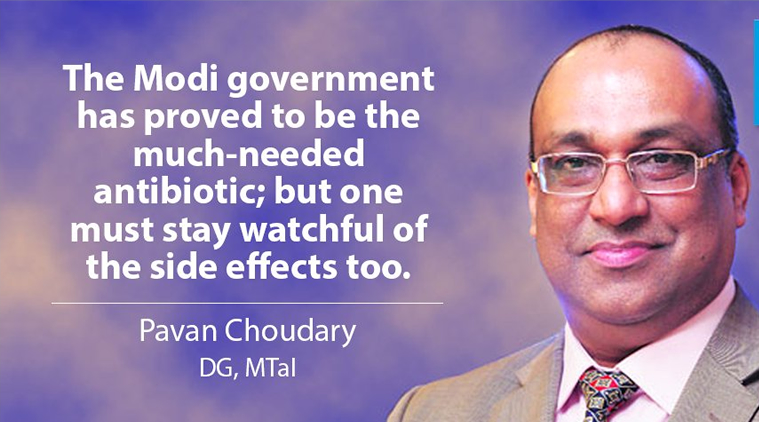Any account of how the Modi government has fared on this front should begin with what the BJP promised in the 2014 election manifesto and whether and to what extent has it been able to keep these promises. Staying within the area of my expertise, I will restrict my argument to the medical technology and hospital sector and assess the government’s performance on some of the most important indices. These two sectors, coincidentally, are those where the government has been most active.

The BJP manifesto sets three goals for healthcare Services: Increase access, improve quality and lower cost. The Term ‘Access’ in healthcare is customarily split into:
- Availability: The government has not interrupted the reach of any technologies. On the addition of beds front its pace is no better than its predecessor. We need to find 1.8 million new beds by the year 2025. The annual addition still trails at a paltry 18,000 beds. Also, there seems little progress on the modernisation of government hospitals which is also an important goal from the manifesto.
- Accessibility: There exists a shortage of 6.5 million healthcare workers and technicians. Institutional facilities to produce these technicians need augmentation and the global medtech companies then need to train them further to make them patient ready. Must say, that in my view, it is for the first time that the PMO is so mindful of the need for capacity increase on this front and is simultaneously encouraging the medtech industry to fulfil its role as a mega- surrogate-employer.
- Affordability: On the affordability front, in January 2016, the government had raised the custom duty on medical technologies, almost across board by 7.3 per cent (which meant an effective duty increase of 62.7 per cent for most devices). Given that 70 per cent of medical devices are still imported, and most of these cannot be import substituted in the immediate term, this surely must have impacted affordability, since all the incremental costs, as is wont, get passed on to the patients. The dominant move of the government towards the goal of providing increased affordability has been through price control.
Stents and knee implants have been brought under price control by the NPPA in February and August 2017, respectively. How much relief this brought to the patients is a moot point still as the procedure costs went up. But the NPPA through its detailed analyses has surely pointed out where the problems lie. So even though the prescription it has administered for stents may lack in the differentiation required and the one for knee implants may have inadvertently overreached to other ancillary devices, none can deny that this experience has given NPPA insights. And NPPA is surely busting any false propaganda in this sector. Another informed body of work generated under the Modi regime is the report of the committee on High Trade Margins in the Sale of Drugs by the Department of Pharmaceuticals (2015), which is in the public domain. Any government (Central or State) which tries to improve patient access through price control, should seriously consider the recommendations of this report.
Summing up my argument so far on affordability – Even when the intention of the government may seem right, its next steps have to be more informed. A significant move of the government towards greater affordability is the launch of government’s e market place (GeM) for Central Government purchases. Though the portal still needs upgrade and can provide better filters to ensure quality, its impersonal interface takes away the moral ambiguity often associated with government purchase. The transparency which e-procurement enables should dramatically bring down cost of government buying.
Another systemic move towards greater affordability is the roll out of the Clinical Establishments Act which the government is facilitating. Healthcare is a business space where doing good is as important doing well. Having thus stressed the importance of doing good, I must quickly add that one can’t feed from an empty vessel. So patient interest should surely be kept at the centre without casting off industry’s reasonable concerns. Market unviability will drive away capital, healthcare worker training and quality, hurting patient interest irreparably.
- Coming to quality: Quality is a function of human expertise, which I have already touched above, and medical technology. One of the important determinants of quality in the medical technology sector is FDI (and technology transfers which go hand in hand with it). This government had the foresight to bring FDI in the medical devices on the automatic route. This single noteworthy move, by encouraging the relevant public, made the FDI surge from an annual average of $63 Million to $161 million in 2015 and to $439 million in 2016. This ascending gradient continued in January-March 2017, however has fallen steeply since. That said unnuanced market interventions or the atmosphere of regulatory unpredictability and haste often drive away strategic investors.
In a nutshell, my verdict on the present government’s performance in healthcare is markedly similar to what I would say of its performance overall. The Modi government has proved to be the much-needed antibiotic; but one must stay watchful of the side effects too. As responsible citizens, we must alert the government to these, as well as to dose titrations which may be needed.
Originally published in Express Healthcare http://bit.ly/2FzVH8B
Published On: Jan 08, 2018